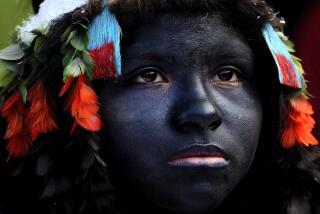Slaves Practiced Capoeira : Afro-Brazil Dance Is Also Martial Art
- Share via
SALVADOR, Brazil — The thief realized his mistake too late: His young woman victim turned a lightning somersault and kicked him in the throat.
She had drawn on the folk art of Brazil’s African heritage to defend herself, using capoeira, a martial art/dance once practiced by slaves and believed to have celebrated the puberty rites of girls seeking husbands in Angola centuries ago.
The woman was a foreigner, one of many who come to Salvador, heartland of Afro-Brazilian traditions, to learn capoeira , considered by its devotees to rival China’s kung fu, Japan’s judo and Korea’s tae kwon do.
There are many capoeira schools here where the young learn to use their feet instead of their fists as offensive weapons, and the athletic are seen practicing it on public squares.
Unlike kung fu, jujitsu and tae kwon do, capoeira is now basically a high-precision stylized dance.
But this was not always so. In the 17th and 18th Centuries, escaped slaves, exponents of capoeira , roamed Brazil, offering their services as mercenaries and bounty hunters, an Afro-Brazilian version of Japan’s samurai.
Even today, as in the case of the woman and the thief, it can be a devastating weapon. In its dance version a performance is heralded by the haunting notes of the berimbau, a resonant one-stringed instrument, played against the background beat of tamborines and drums.
The dancers, wearing only loose white pants, cross themselves with a pinch of dust, touch hands and begin the stylized combat, at first slowly, standing on their hands and performing slow cartwheels and somersaults.
Twirling, kicking and feinting, their movements match the music’s quickening beat until the feet of the tumbling performers swish within a hair’s breadth of each other’s face.
A split-second lack of concentration and a whirling foot would deal a blow as sharp as a karate chop.
Its origins are obscure, but most authorities trace it to southern Angola, possibly to the Mucope tribe, whose young men staged a dance called N’golo during the puberty rites of village girls seeking husbands.
The contest’s winner was able to choose the prettiest without having to pay a bride price. It is thought the tribesmen brought the art to Brazil when the Portuguese shipped them as slaves to sugar plantations.
When the Dutch invaded Brazil in the 17th Century, many slaves escaped from plantations as their Portuguese masters reduced security in order to send more men to war.
The Africans set up their own republics inland and the exponents of capoeira became their guerrilla army.
After the Portuguese threw out the Dutch and crushed the small independent states, capoeira fighters roamed the country, offering their martial services.
More to Read
Sign up for Essential California
The most important California stories and recommendations in your inbox every morning.
You may occasionally receive promotional content from the Los Angeles Times.













